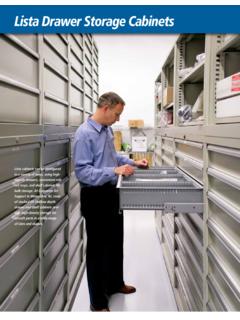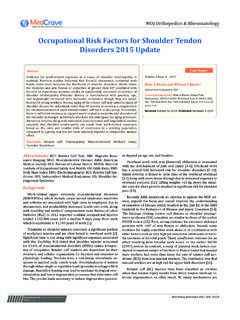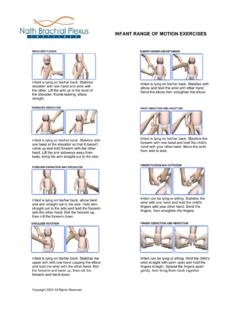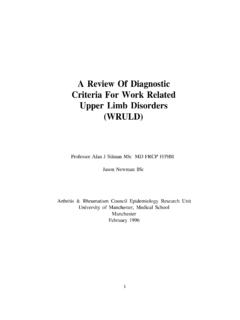Transcription of Four Simple Ergonomic Steps to a More Productive …
1 Four Simple Ergonomic Steps to a More Productive Workplace Paying attention to ergonomics pays off By James Anderson Vertical Market Manager, Lista International Corp. Workplace ergonomics is getting a lot of Ergonomics designing the job to attention nationwide in response to a sharp fit the worker increase in incidents of repetitive strain injuries Ergonomics is the science of designing a job resulting in musculoskeletal disorders, such as to fit the worker, rather than physically forcing carpal tunnel syndrome. Occupational diseases the worker's body to fit the job.
2 By adapting often mean repeated surgery, intractable pain, tasks, work stations, tools, and equipment to fit inability to work, time off for the affected the worker, ergonomics seeks to reduce physical employee, and, ultimately, higher costs for the stress on a worker's body and eliminate many employer. potentially serious, disabling work-related muscu- factors including work surfaces at the wrong loskeletal disorders (MSDs). height, uncomfortable If work tasks and equip- chairs, shelves and bins that ment do not include Ergonomic are too high or out of reach, principles in their design, work- and awkward hand tools, all ers may have exposure to undue contribute to increased risk physical stress, strain, and of musculoskeletal disorders overexertion, including vibra- injury and may offer a nega- tion, awkward postures, forceful tive impact on productivity.
3 Exertions, repetitive motion, There is a wealth of and heavy lifting. options available to adjust the workspace to meet employees' Ergonomic needs and selecting the right ones can help Step 1 Review tasks for risk employees reap significant bottom line rewards. factors Paying attention to ergonomics means removing The first step to correcting problems is to barriers to work productivity. Comfortable understand the key workplace Ergonomic risk fac- employees stay at their desks or work stations tors and review work tasks in your operation to longer, and complete more work in a given shift.
4 See which ones apply. This can make a tremen- Employers who pay attention to these four Simple dous difference, since occupational safety profes- Steps are well on their way to gaining these sionals estimate that reducing physical stresses rewards. could eliminate as much as half the serious LISTA INTERNATIONAL CORP. FOUR Ergonomic Steps TO A Productive WORKPLACE. injuries that happen each year. Predicting what might go wrong and modifying tools and the work environment to make tasks safer for work- ers is the first step to reducing problems.
5 Table 1. (below) lists these key risk factors and notes the injuries each may cause. Figure 1 (page 3) illus- trates a few of these factors . Table 1 MSD Risk factors Force Exerting excessive force can cause a variety of injuries. Repetition Excessive repetition of movements can irritate tendons and increase pressure on nerves. Awkward postures Positions that stretch physical limits can com- press nerves and irritate tendons. Static postures Positions that a worker must hold for long peri- ods of time can restrict blood flow and damage muscles.
6 Quick motions Increased speed or acceleration when bending and twisting can increase the amount of force exerted on the body. Compression or contact stress Grasping sharp edges like tool handles can concentrate force on small areas of the body, reduce blood flow and nerve transmission, and damage tendons and tendon sheaths. Recovery time Inadequate recovery time due to overtime, lack of breaks, and failure to vary tasks can leave insufficient time for tissue repair. Vibration Excessive vibration from tools can decrease 2. blood flow, damage nerves, and contribute to muscle fatigue.
7 Whole body vibration can affect skeletal muscles and cause low-back pain. Cold temperatures Working in cold temperatures can adversely affect a worker's coordination and manual dex- terity and cause a worker to use more force than necessary to perform a task. Source: Adapted from Ergonomics: The Study of Work, Department of Labor, Occupational Safety and Health Administration, OSHA 3125, 2000. LISTA INTERNATIONAL CORP. FOUR Ergonomic Steps TO A Productive WORKPLACE. Figure 1 Selected Risk factors 3. Source: Elements of Ergonomics Programs, A Primer based on Workplace Evaluations of Musculoskeletal Disorders LISTA INTERNATIONAL CORP.
8 FOUR Ergonomic Steps TO A Productive WORKPLACE. Step 2 Control risk factors with Of equal impact are administrative controls, engineering and administrative adjusting work practices and policies to reduce controls, and personal equipment, risk factors . Examples include rest breaks, job where it is effective rotation, or training to identify signs of ergo- nomic stress. Engineering controls, administrative controls, Finally, personal equipment may be consid- and personal equipment are the three key ways ered, including wrist supports, back belts, or to control the risks identified earlier.
9 Examine vibration attenuation gloves. However, it should each of these to see how each may be used to be noted that, although personal equipment may control the risks identified in Step 1. reduce the duration, frequency, or intensity of Engineering controls to improve Ergonomic exposure to risk, their effectiveness in injury risks may include changing the way parts and reduction is considered inconclusive by National materials are transported; changing the process to Institute for Occupational Safety and Health reduce how workers are exposed to risk factors .
10 (NIOSH). Figure 2 is an illustration of the general moving parts around to make it easier for work- ways of reducing the risk factors identified in ers to reach them; or changing work station lay- Step 1. out, tool design, or access and assembly sequence. Figure 2 Controlling Risk factors 4. Source: Elements of Ergonomics Programs, A Primer based on Workplace Evaluations of Musculoskeletal Disorders LISTA INTERNATIONAL CORP. FOUR Ergonomic Steps TO A Productive WORKPLACE. Step 3 - Understand how to make the work space work ergonomically With any task, selecting the proper tool is crucial.








